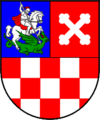Čazma
Čazma is a town in Bjelovar-Bilogora County, Croatia. It is part of Moslavina.
Čazma | |
|---|---|
| Grad Čazma Town of Čazma | |
Center of Čazma | |
 Čazma | |
| Coordinates: 45°45′N 16°37′E | |
| Country | |
| County | |
| Government | |
| • Mayor | Dinko Pirak (HSS) |
| Area | |
| • Total | 240 km2 (90 sq mi) |
| Population (2011)[1] | |
| • Total | 8,095 |
| Time zone | UTC+1 (Central European Time) |
Geography
Čazma is situated 60 kilometers east of Zagreb and only 30 kilometres from the center of the region - Bjelovar. Čazma is situated on the slopes of Moslavačka gora, surrounded by fertile lowlands. The river Česma runs to the east of Čazma and the smaller river Glogovnica flows into it nearby, too.
History

The town of Čazma is one of the oldest towns in the Republic of Croatia. It was mentioned in 1094, when the Hungarian king Ladislav gave Čazma as a possession to the bishop of Zagreb. The year that is mentioned as the year of Čazma's foundation is 1226, when bishop Stjepan II Babonić established a parish, built a Dominican monastery and - today far known for its cultural worth, the Church of saint Mary Magdalene, which gave the parish its present name. The church is the only preserved monument of the earliest written eight hundred-year history of the city. It is a unique example of romanic architecture in northern Croatia and experts equate its value with the Zagreb cathedral. The church organ made in 1767 are one of the most beautiful in Croatia.
Janus Pannonius (Latin: Ioannes Pannonius, Croatian: Ivan Česmički, Hungarian: Csezmiczei János, or Kesencei; 29 August 1434 – 27 March 1472) was born here who was a Croat-Hungarian Latinist, poet, diplomat and Bishop of Pécs. He was the most significant poet of the Renaissance in the Kingdom of Hungary and one of the better-known figures of Humanist poetry in Europe.
The town was occupied by the Ottoman Turks in 1552, who established their sanjak there. The town stayed under Ottoman rule for 54 years until it was liberated by Croatian Ban Toma Bakač Erdedi and his army in 1606.
In the late 19th and early 20th century, Čazma was a district capital in the Bjelovar-Križevci County of the Kingdom of Croatia-Slavonia.
Economy
Its economy is based on small and middle-sized companies which manufacture final products from natural goods. Tradespeople, together with agricultural manufacturers, direct their development to services, production and tourist potential.
Half of the region where the town of Čazma is situated spreads out on agricultural land and as much as 44 percent is forested. Mineral wealth in the soil: quartz-sand, clay, stone etc., and especially springs of drinking water of great quality, enable various investments and building of plants, operation facilities and production lines.
The best known company from Čazma is Čazmatrans (transport company), which was established 1949.
Demographics
The town has a population of 2,801, while the municipality consists of 36 villages, inhabited by a total of 8,077 people.[1]
- Andigola
- Bojana
- Bosiljevo
- Cerna
- Dapci
- Dereza
- Donji Draganec
- Donji Dragičevci
- Donji Miklouš
- Gornji Draganec
- Gornji Dragičevci
- Gornji Miklouš
- Grabik
- Grabovnica
- Komuševac
- Marčani
- Milaševac
- Novo Selo
- Općevac
- Palančani
- Pobjenik
- Pobrđani
- Prnjarovac
- Prokljuvani
- Sišćani
- Sovari
- Suhaja
- Vagovina
- Vrtlinska
- Vučani
- Zdenčec
According to the 2011 census, 98% of the population are Croats.[2]
References
- "Population by Age and Sex, by Settlements, 2011 Census: Čazma". Census of Population, Households and Dwellings 2011. Zagreb: Croatian Bureau of Statistics. December 2012.
- "Population by Ethnicity, by Towns/Municipalities, 2011 Census: County of Bjelovar-Bilogora". Census of Population, Households and Dwellings 2011. Zagreb: Croatian Bureau of Statistics. December 2012.
